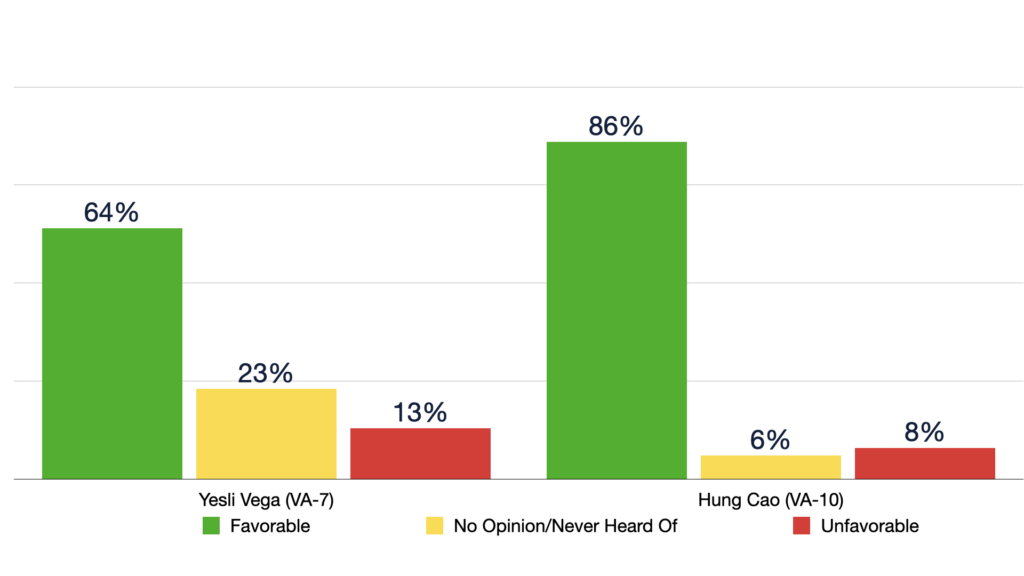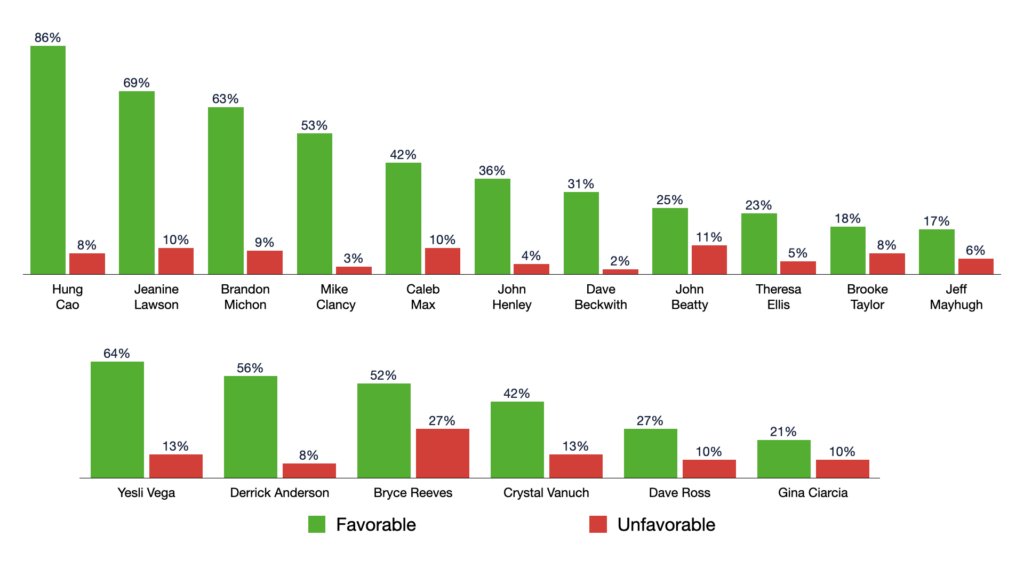Measuring The Effects Of Ranked Choice Voting In Republican Primaries
A recent survey of Republican primary voters in Virginia’s 7th and 10th Congressional Districts conducted by 3D Strategic Research on behalf of the Center for Campaign Innovation found that both the winner and runners up in the 10th District’s ranked choice voting (RCV) firehouse primary emerged from the contest with higher net positive images than their counterparts in the 7th District’s plurality primary. Additionally, voters in the 10th District reported a more positive overall campaign than voters in the 7th District.
Between 2000 and 2018, the number of primaries with more than 3 candidates at the federal level alone has tripled.
These findings lead to important considerations for elected officials and party representatives as they seek to address increasingly crowded primaries. Previously major donors, party officials, and senior politicians played an important role in “consolidating” primary fields to select a nominee. However, more accessible technology like social media, online fundraising, and voter data makes it easier than ever for a candidate to run a competitive campaign with limited experience or financial backing. As a result, primary campaigns are becoming more crowded than ever before leading to more nominees winning with a plurality – rather than majority – of support. Between 2000 and 2018, the number of primaries with more than 3 candidates at the federal level alone has tripled.
Key Findings
- The Republican nominee in CD10 selected by ranked choice voting emerged from the contest with a higher net favorable image (+78) than the GOP nominee in CD7 selected by a plurality (+51).
- 84% of voters in CD10 said the Republican candidates ran a somewhat or mostly positive campaign compared to 59% in CD7. 17% of moderate primary voters in CD7 rated the campaigns as negative, compared to just 4% in CD10.
- In CD10, the two runners-up (Lawson & Michon) had a higher net favorable image than the winner (Vega) did in CD7.
While the increasing size of primary fields offers voters more choices and may lead to more diversity and a wider issue set, the plurality winner system of most primaries in the country means candidates must take vote share away from their opponents with negative campaigning. Not only do voters disapprove of negative campaigning, it also has the potential to weaken the party’s eventual nominee as well as other candidates within the contest.
A Unique Opportunity
In Virginia, the political parties have historically enjoyed broad leeway to determine the method of nomination for their candidates. This includes party-run processes like conventions which are held in a single location on a single day or so-called firehouse primaries held at multiple locations with flexible timing. The parties may also opt for a state-run primary election with a plurality winner and no runoff requirement.
In response to limitations on in-person gathering following the COVID-19 pandemic, Virginia Republicans adopted an “unassembled” convention which employed ranked choice voting to nominate their statewide candidates in 2021. Following the success of that process which led to the nomination of Virginia Republicans’ first statewide elected officials in more than a decade, three congressional district party committees adopted RCV in 2022. In the 8th, 10th, and 11th congressional districts, Republicans nominated their candidates via RCV.

Virginia’s 10th Congressional District also neighbors the 7th Congressional District, sharing portions of Prince William County. Republicans in the 7th opted for a state-run primary. This offered a unique opportunity to test the effects of the method of nomination on candidate images and voter perceptions of campaign quality.
Election Results
Eleven candidates filed and were qualified to run in the 10th District nominating process. The 10th Congressional District Republican firehouse primary was conducted on May 21, 2022, with options for early and military overseas voting. 15,174 ballots were cast at 11 voting locations across the district. Upon conclusion of voting, the paper ballots were hand counted by volunteers and staff at the 10th District GOP headquarters. After 9 rounds of counting, Hung Cao won the nomination with 52% of the vote.
The six candidates seeking the Republican nomination in the 7th faced voters at the June 21st primary. 37,708 votes were cast and Yesli Vega won the nomination with 29% of the vote.
Ranked Choice Voting Resulted In A More Positive Campaign
In the 10th Congressional District, 84% of voters described the campaign as positive compared to just 59% in the 7th Congressional District. Two-thirds of voters in the 10th rated the candidates as having run a mostly positive campaign, with an additional 18% saying the race was somewhat positive.

The difference in perception of the quality of the candidates’ campaigns was even more pronounced when comparing soft Republicans, Democrats, and Independents. Only 42% of these more moderate voters said the candidates in the 7th District ran positive campaigns compared to 86% of soft Republicans, Independents, and Democrats in CD-10.
Ranked Choice Voting Resulted In A Better-Positioned Nominee
Because the nomination contest in the 10th Congressional District was considered more positive than in the 7th, Hung Cao, the Republican nominee chosen via RCV, emerged with 86% favorability among voters. In the 7th, Yesli Vega’s favorability among primary voters was just 64%.

Cao was also better known by voters with 94% name identification compared to 77% for Vega in the 7th. This is likely due to the fact that in the RCV firehouse primary, voters were able to indicate preferences for each candidate and researched all of the options. Indeed, 97% of ballots had enough preferences to be counted for all nine rounds.
Ranked Choice Voting Also Benefited Runners Up
By removing incentives to attack candidates, the RCV firehouse primary in the 10th District also benefited those candidates who did not win. Jeanine Lawson, who finished second behind Cao, had a +59% net favorability. Brandon Michon, the third place finisher, had +54% net image.
This is an important asset to the Republican Party of Virginia because Lawson serves on the Prince William County Board of Supervisors and may seek re-election in 2023.
Contrast this with images of the runners up in the 7th District. State Senator Bryce Reeves, considered the frontrunner for much of the contest, finished with the highest unfavorability rating we measured at 27%. While he still has a net +25% positive image, Reeves faces a contested primary to retain the newly redrawn senate district next year.

Ranked Choice Voting Did Not Affect The Outcomes
In the 10th Hung Cao led the field on the first ballot with 42%. He added to his majority over each round by collecting second, third, fourth, and fifth choice preferences from voters. All things being equal, in a plurality contest, Cao would have also become the nominee.
In the 7th District, respondents in the survey were asked to rank their preferences among the candidates. In this simulated RCV contest, Vega still emerged as the consensus choice for voters.
While the method of nomination did not appear to alter the outcomes in both contests, the effects of leveraging RCV in the 10th are clear in terms of impact on candidates’ favorability.
Republican Primary Voters Preferred Ranked Choice Voting
In the 10th District, 56% of voters reported preferring RCV to a single choice with one in three strongly preferring the method. Just one in four voters in the 7th District preferred ranking candidates.

Opportunities For Increased Use Of Ranked Choice Voting In Virginia
Currently, Virginia laws only permit RCV in local elections for county boards and city councils. If Republicans want to take advantage of the benefits of RCV, they must do so in party-run contests which limit the number of voters who can participate. Legislation sponsored by Delegate Glenn Davis in 2021 would have extended RCV as an option to nomination contests for both parties at all levels.
A majority of Republicans surveyed in the 7th District (54%) said they are familiar with RCV, but more education and awareness should accompany an expansion of its usage. 28% reported they are not at all familiar with the voting method.
Conclusion
Proponents of ranked choice voting cite more positive campaigns and more informed voters as one of the method’s key benefits. Some observers credit the usage of RCV in the 2021 Virginia Republican unassembled convention that nominated now-Governor Glenn Youngkin as a key factor in GOP victories.
The neighboring 7th and 10th Congressional Districts in Virginia offered a unique opportunity to measure and test these hypotheses. Each nomination contest was for a challenger against a Democratic incumbent in suburban-rural districts that neighbored each other.
Methodology
3D Strategic Research conducted post-election surveys of Republican primary voters in Virginia’s 7th and 10 District. Surveys were conducted the day of the election after polls closed and the following day. The CD-10 survey fielded May 21-22, 2022 among N=248 Republican primary voters and has a margin of error of +6.2%. The CD-7 survey fielded June 21-22, 2022 among N=258 Republican primary voters and has a margin of error of +6.1%. Both surveys were conducted with a mix of live calls to landlines and cell phones, and text messaging inviting respondents to take the survey via secure weblink. Minimal weights on region, gender and the ballot were applied so survey data reflected the actual election results.